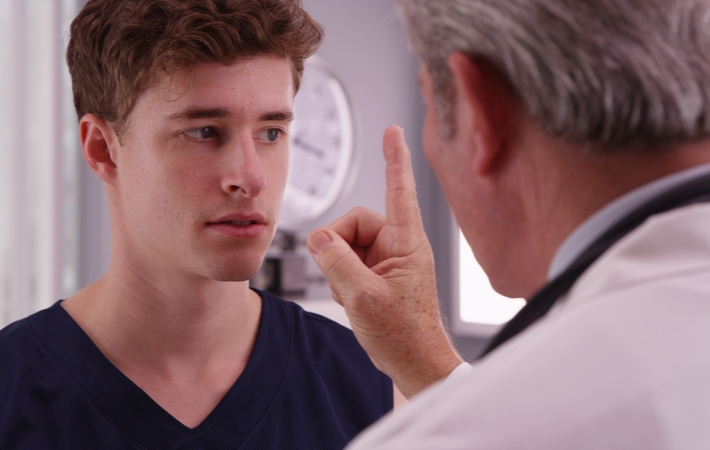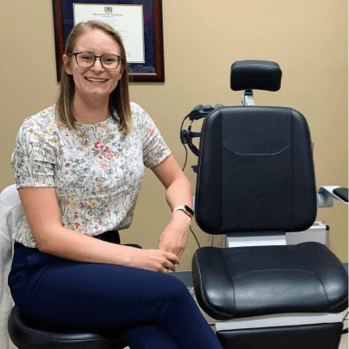Brain Injuries & Vision Changes
Each person experiences a brain injury differently. The neural network is a complex system, and many things can go awry after a brain injury—including changes to your vision.
Your eyes and your brain are intrinsically connected. Following a brain injury, you may notice changes to your vision right away or gradually as you recover.
Vision is a delicate and indispensable sense that we use every day. It can be affected by brain injuries like concussions, strokes, brain tumours, neurotoxicity, and neurodegenerative diseases like Parkinson’s.
Thankfully, there are ways we can rehabilitate connections between the brain and the eyes to help restore vision.
Identifying the Issue
When someone suffers a brain injury, they may not notice immediately that their vision has been affected. There are a handful of ways vision is commonly impacted, and there are solutions like vision therapy available.
Optometrists at Beyond 20/20 will assess your entire visual system to help you identify areas that could benefit from vision therapy..
Visual Skills Are Vital
If you are experiencing vision changes following a brain injury, you may benefit from vision therapy to help you rehabilitate your visual skills.
There are several changes patients often experience after a brain injury. Still, it’s important to remember that everyone will experience these differently. And, vision changes can affect more than the clarity of sight.
- Focusing: Many patients describe that it feels like their vision “goes in and out,” or it feels like it’s lagging. You may need more than an updated prescription to resolve the issue.
- Double vision: Double vision when reading can be common after a brain injury. The words may appear to float or move on the page.
- Reading speed: You may be able to read for a few minutes, but after prolonged reading, you can’t keep track of the words and lines on the page.
- Light sensitivity: Also known as photophobia, increased sensitivity to light can make it difficult to see in brighter environments, on screens, or under fluorescent lighting.
- Peripheral vision: Changes to peripheral vision may be noticeable, especially in crowded or busy environments.

Visual Rehabilitation
The first step to building your unique visual rehabilitation plan is to complete an acquired brain injury evaluation and a binocular vision assessment to assess your current visual skills.
Because 90% of traumatic brain injuries result in visual dysfunctions, having a vision therapy plan tailored to your unique needs is an important part of your overall rehabilitation.
An acquired brain injury evaluation will assess if your eyes are:
- Working together properly—moving together (teaming) and tracking moving objects.
- Focusing between objects in the distance and up close easily and quickly.
- Experiencing any sensitivity to bright lights and changing light environments.
- Processing images properly to send information accurately to the brain (visual processing).
Typically, an acquired brain injury evaluation and a binocular vision assessment take around 2.5 hours to complete, but it may be split up into several sessions or combined with other assessments if needed.
Your optometrist will use this assessment to personalize your vision therapy treatment to help you reclaim your vision.
The Vision Therapy Program
Each person’s vision therapy program will be different.
Therapists design the programs unique to each individual, enhancing and building upon vital visual skills needed for day-to-day life.
A typical vision therapy program includes weekly sessions that will take you through different brain and eye training exercises to improve your visual skills. In between sessions, patients complete “homework” exercises to keep working those connections.
Tools used in vision therapy may include:
- Therapeutic lenses
- Prisms and filters
- Electronic targets
- Timing mechanisms
- Balance boards
- And more!
Discovering Your Visual Potential
Vision therapy is available to anyone who requires assistance developing their visual skills—and it is an essential component of recovering from a brain injury.
Because each vision therapy program is completely unique, building on the connection between the eyes and the brain is appropriate for any age. Children and adults can benefit from vision therapy to help improve reading, depth perception, peripheral vision, and more.
Your optometrist may identify visual skills you could improve at your routine comprehensive eye exam. No matter your age, regularly scheduled eye exams are the key to achieving your greatest vision possible.
Talk to your optometrist today if you have any questions. Beyond 20/20 is always happy to help!




